Entrelac knitting is famous for its unusual knitting technique. This method was previously used to create stockings, where the pattern was a square of 10 loops. The loops had to be knitted in one direction, and then in the other. The continuous fabric resembles patchwork technique, and crocheted from yarn - a basket made of many squares.
Multidirectional loops are easy to work with, beginners should strictly follow the pattern. Unlike the patchwork technique, enterlak, according to the description, should be knitted not in fragments, but as a whole piece.
Basics of technology
Knitting in the style of enterlak crochet (for beginners, patterns with descriptions will be presented below) consists of creating a Tunisian cloth in the form of square patterns.
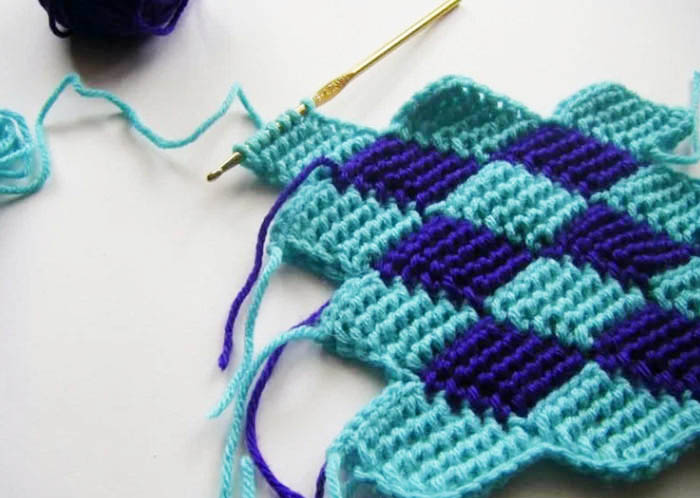
If in the checkerboard pattern of the patchwork model all the squares create a dense fabric, then in the enterlak technique softer models are obtained in crochet knitting. They are less subject to stretching, unlike knitting with needles.
The technique of braided knitting is somewhat different from the standard knitting pattern:
- The canvas is monochromatic and does not consist of several fragments.
- For knitting you can choose a hook of different sizes.
- The threads do not need to be broken during the process of creating rows with loops directed in different directions.
- A single-color braid looks great as a pattern on a hat, scarf, or sweater.
- Multi-colored patterns complement the appearance of sweaters, coats, and blankets.
- You can alternate threads in each row or every few rows.
The patterns consist of colored stripes of different widths and heights. As a rule, the pattern repeat is 10 loops. Even rows can be knitted with a tilt to the right, when the odd ones lie in the opposite direction. You can use yarn of any shades that combine in the overall picture.
Some craftswomen use threads of one color so as not to tear the yarn, but to continue the whole pattern. It is also acceptable to combine colors through several squares in the same row or through several rows in the rapport pattern.
Knitting pattern enterlak
The simplest crochet pattern is considered to be the standard rapport size of 10 cm.
To do this you will need:
- Sectionally dyed yarn, which may contain 50% wool and the same amount of acrylic. Consumption is 110 g with a yarn thickness of 390 m/100 g.
- Hook #3 or larger.
- Large needle for securing threads.
- Scissors are needed to cut the yarn.
The crochet pattern is shown below in the picture. One of the typical rapports contains the designations and directions of the loops in each of the rows.
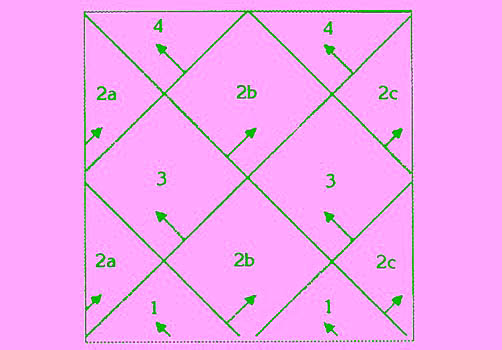
To better understand the designations of the scheme, deciphering will help. They are often replaced by signs, numbers and other figures.
| VP | air loop front or back |
| SP (connecting p.) | Slip stitch or half double crochet depending on the position of the loops |
| SBN | Single crochet only |
| PSN | Half double crochet |
| SSN | Column with one yarn over |
| RSSN | Relief pattern in a column with one yarn over in a front or back loop |
Knitting in the style of enterlak crochet (for beginners, patterns with descriptions are presented in master classes) is often described as a pattern of knitting patchwork. In this regard, combined loops with a pattern are often used. Instead of knitting a whole pattern separately in a loop, it was customary to borrow figured loops and introduce the use of RSSN into circulation.
To properly connect the relief, you need to do the following separately for it:
- First you need to knit an elastic band, starting from the front row.
- Then you need to cast on several rows with alternating loops.
- If the first loop is a purl one, then the next one will be in the form of a half double crochet.
- If you first knit a half double crochet, then you need to knit a front loop next.
The rib pattern consists of alternating loops in each row. It should be knitted when the loop abbreviation is marked in the diagram.
The typical pattern uses a standard enterlac pattern, which consists of a set of 2-3 loops:
- The height of the product according to the rapport is 8 carats and 1 half-rhombus.
- First, loops are cast on, for example, the length of the product requires 160 sts.
- Of the total number of loops, 158 sts will be used to knit the pattern.
- According to the rapport, the number of loops for the pattern must be divided by the number of squares.
- If the number of loops cannot be divided into equal parts for diamonds, you need to select half the loops from one diamond or square to knit a half diamond.
- At the end of each row, you will usually need to knit a finishing or slip stitch to close the stitches of the row into a circle.
Many people note the advantage of working with a crochet hook, since the technique involves solid knitting. On the knitting needles, you need to periodically move the loops, remove them and return them back. It is more difficult to knit a multi-colored pattern with a free knitting needle when there are more than 3 types of shades. It is much easier to do this with a crochet hook, since you can continuously knit a pattern in each row, making broaches.
Master class
A beautiful pattern is one that uses different colors of yarn. However, many people still have questions related to the fear of knitting something incorrectly.
Before you start knitting, you need to consider the main mistakes that can be made for the first time:
- It is necessary to constantly check the rapport and knitting pattern of the entire product.
- The first and main stage, which will lay the foundation for the future product, is the first row of loops.
- First you need to knit triangles, choosing yarn of a certain color.
- The triangles should then form squares. This can be done as a whole pattern or by knitting two triangles together.
- The triangle shapes will be knitted in different directions, so it is important to remember on which row the front and back loops are constructed, as well as where the triangles of one square are located.
- The second stage is considered the most difficult. The edge loops must be tied very carefully. The appearance of the product depends on this. Its main function is to divide the fabric into color parts depending on the direction of the loops.
- To knit the squares, you need to knit a solid triangle using the turning method. This involves knitting the stitches back and forth.
- All work will continue until the product reaches the desired shape.
- In the third stage, you need to carefully knit the last row so that it matches the rapport pattern. Absolutely all loops need to be closed as edge loops. To do this, you need to knit both loops together, and the next ones need to be connected to the previous one. It will be formed as a result of combining two loops.
- At the end of the work you should always tie a knot. The yarn should be pulled through the last loops so that the work looks neat.
Knitting in the style of enterlak crochet for beginners (patterns with descriptions need to be adjusted to an individual pattern) may seem too complicated. To correctly knit even the simplest pattern, you need to choose the materials.
Thin yarn is suitable for summer covers, shawls. A warm winter sweater should be made of thick threads. Sometimes both a hook and knitting needles are used for the enterlak style.
Enterlac style hat
Most often in this style you can find products intended for wearing in winter. These can be socks, scarves and hats. In order for a fashionable wardrobe item to decorate and complement the chosen image for a walk or outfit, the master class will present the process of knitting a hat.
First, you need to prepare the materials for knitting the diamonds:
- In the first circular row you need to knit diamonds for the base of the hat.
- First, you need to dial a chain of air loops: 160 VP without a feed loop.
- Then you should pick up loops from the second VP from the edge without knitting.
- As a result, you will get 13 open VP, of which 12 loops will be working.
- For odd rows, you should cast on open loops without further closing.
- For the second row you need to knit from left to right: 1st VP needs to be knitted as edge st. Then you need to knit 2 VP together.
- When the loops in the even row are finished, you need to close the row with edge stitch.
- In the 3rd row, you need to form the beginning for each diamond. To do this, at the end of each odd row, dial 1 VP from the next loop of the initial dialed row after dialing 12 VP. This means that there will be 13 open loops, of which one is dialed additionally.
- Next, it should be connected to the last connecting loop.
- The odd rows with 13 open VPs and 13 closed VPs in the even rows will remain in the work. In this case, it is necessary to take into account the constant open loop in each row at the beginning of the row.
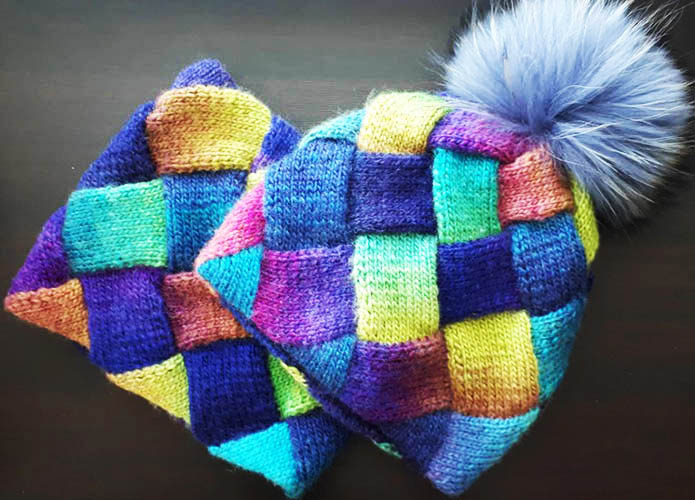
In this way you need to knit diamonds up to the 27th row.
- Next, in the last 27th row, only on the closed loops of the even row, you need to knit a row of sc to the end.
- The work will use 26 VPs out of 160 initial ones.
- To knit the second diamond, you first need to dial 1 VP.
- Then you need to knit 12 VP from the following loops along the cast-on row. As a result, you will get 13 open VP.
- The second diamond should be knitted in the same way.
- After finishing knitting the 2nd diamond, 54 loops out of the initial 160 will be used in the work.
- Additional diamonds in the 1st circular row (4 more need to be knitted) should be knitted according to the pattern, like the previous ones for the cast-on row.
Having crocheted all 6 diamonds for the current row according to the description, all 160 loops will be used for the cast-on rows. In the enterlac style, the last loops in such rows must be crocheted through a connecting loop. This is necessary to combine the row into a circle. According to the diagram, the last and 1st loops of the 6th diamond must be connected.
For beginners, this stage is considered the most difficult, but then you need to continue knitting in a circle.
- For the 2nd circular row, you must first knit 14 sl sts. The stitches must have the same edges and corner heights so that subsequent diamonds match the last diamond in the previous row.
- Without breaking the thread, it is necessary to cast on 12 VP from the top point of the first diamond in the first circular row down along the edge and the outer side of the diamond. There will be a total of 12 open loops in the work. They are needed for the first row of the first diamond in the 2nd circular knitting row.
- You need to knit the first figure in the same way.
- To connect the diamonds together in the 2nd circular row, you need to knit 1 VP in the same way as in the first row.
- In this case, all the loops of the 1st odd row must be picked up from the edge for each diamond. They must correspond to the sides of the diamonds in the 1st row.
- The auxiliary VP at the end of an even row is collected from the next rhombus in the same row.
- For odd circular rows #3-5, you need to knit VP in a similar way: from the previous circular row from the edge of the subsequent diamonds.
For rows 6-7, you need to reduce the size of the diamond: on the last circular rows, you should decrease the height and width by 1 VP.
- For the 6th circular row, you need to knit a diamond from the loops of the previous one. First, you should dial 13 VP and knit 3 VP at the end of the second row.
- In the 3rd row, you need to dial the same number of open loops, as well as 1 additional one from the top row.
- The size of the diamond will be 12 VP on each side.
- The entire row must be knitted according to this pattern.
- For the 7th row, you need to make decreases in width and height. In relation to the size of the rhombus, you need to decrease the entire value by 1 VP on each side. The entire row should be knitted this way.
- The bottom edge needs to be aligned. To do this, you need to dial 13 more VP from the edges of the figures. As with the circular rows, you need to form a half-diamond so that the decreases are uniform for the ends of the even rows.
- Then you need to tie together 3 PVM until the end.

When the height of the figures is 26-28 rows, you can begin assembling the product.
- You may need a hook or needle for assembly.
- It is necessary to connect all the corners of the figures at the vertices.
- From the finished closed loops you need to form the bottom of the headdress.
- For the bottom edge of the hat, you need to make a binding. To do this, you need to knit one row of CCH
- The next row should be knitted with a 1*1 elastic band.
The finished product must be hand washed and dried on a horizontal surface. A pompom can be used for decoration.
Pattern by squares
Knitting in the style of enterlak crochet for beginners (the patterns with the description must be read correctly taking into account the rapports) may seem difficult if you want to knit multi-colored products. In such cases, you can resort to breaking the threads if the action is justified by inexperience. As a rule, masters can knit a pattern with several hooks.
The most interesting pattern is considered to be squares, which resemble Tunisian cloth. The rapport can be used in various loose-fitting sweaters, turtleneck sweaters and scarves.
First you need to make the base:
- You need to dial 26 VP.
- Next, you need to put 5 VP on the hook without the feeder.
- Then the knitting method changes to the reverse side. To do this, the loops need to be returned as follows: the first VP should be knitted together, and then you need to pick up the VP from the previous row.
- Next, you need to take the 5th VP from the general chain, and the first 2 need to be taken from the next row to tie them together. So you need to continue knitting five rows. As a result, you will get a square.
- After knitting the square, the loops need to be closed.
- Then you should move on to another color of yarn. During this transition, you do not need to knit columns.
- From the chain of air loops you need to take five VP again and do the same as in the previous step. When the square is connected, the loops can be closed.
- The following squares should be knitted in the same way, moving from one color of yarn to another.
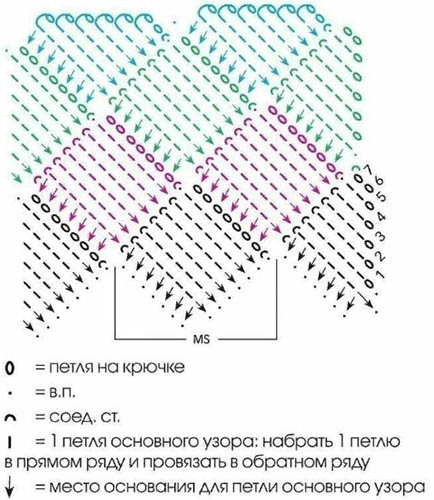
When the product has already received the desired shape, the loops need to be knitted together until you get 4-6 free VP. They need to be knitted together and closed with a feeding loop.
Patchwork Enterlac
If enterlak is to be knitted with clear squares or diamonds, then the patchwork or nuking style can be combined with other techniques, moving away from a strict pattern. For example, in the enterlak style, you can knit patterns in the form of leaves, elastic bands, unusual patterns, which will also be directed to the right and left along even and odd rows.
Along with this, Tunisian crochet with large patches is used when it is necessary to create several patterns and combine them into a single fabric.
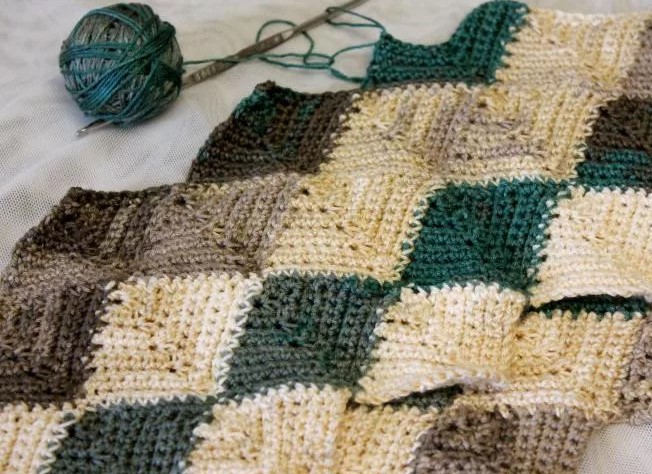
Enterlac in patchwork technique does not differ in the choice of materials and tools.
To work you will need:
- Batic Gold yarn from the Angora series 110 g/600 m (contains 25% wool and 75% acrylic). For large M-XXL items, 130 g will be needed for the pattern rapport, for small patterns 90-100 g of yarn will be enough.
- Hooks #2.5 for SM products and #3-3.5 for M-XXL. It is also worth paying attention to the knitting density and pattern rapport. You can use a Tunisian hook, but a regular one will do.
- To crochet Tunisian stitches you can use a long hook, but a regular hook will do as well.
- The elastic band should be crocheted using the simplest, smaller hook.
- Squares can be knitted in different ways; for patchwork, a knitting style from two different sides is suitable.
Knitting in the style of enterlak crochet (for beginners, the patterns with descriptions should contain information on step-by-step work) in the patchwork technique contains several squares of 15 VP. The size can be changed taking into account the consumption of all loops.
If the sides have 15 VP, then in the middle it is necessary to knit an additional 1 VP.
- In the first row, you need to knit 14 sc. You should add 3 more sc to them, knitting them together. Then you need to close the row, knitting another 14 sc. All the columns can be knitted in the usual way or through the back wall through a half loop. This method allows you to make the pattern relief.
- Then you need to tie 3 sc together for each row. The result should be a square.
- Next, cast on 14 sc along the top side, add 1 ch, then cast on another 14 ch for the other side of the 2nd square.
- Then you need to knit the second square like the 1st. In this way you can knit squares of the required sizes.
- The entire piece should be the right size, each square should be knitted according to the pattern.
- Based on the squares, you need to knit a rectangle of 2 figures together.
- For a rectangle, you should knit 15 VP and add 1 VP. Then you need to knit another 30 VP with 1 auxiliary VP. The entire row should be closed with 15 VP.
- Then you should make decreases in the columns on both sides.
The product then needs to be knitted according to the pattern as a schematic square of 3 figures.
Product options
Very often you can find not only accessories knitted using the enterlak technique, but also large works that are characterized by elements of Tunisian crochet, combined crochet and knitting techniques, as well as various auxiliary styles such as patchwork.
| Cover | You can knit in the style of enterlak, or resort to a full patchwork with Tunisian crochet. You will not have to break the threads, you can combine the color of the yarn and transfer the rapport to auxiliary knitting needles so that the work is done only with a hook in the working area. |
| Mittens | For such items, a crochet pattern in the form of imitation knitting is suitable. As a rule, one tool is used in the work, but the pattern is similar to diamonds, as in the case of knitting with intermittent squares of different yarns. |
| Socks | Like mittens, you can knit in different colors. Often there is a combination of "Fujiyama" with patchwork elements, where each area of the pattern is done in the enterlak style. |
| Cardigan | It is most convenient to knit in the classic style with a crochet hook, but for the speed of work a Tunisian hook with a large heel is used. Large lush yarns are selected for work. |
| Bags | The ideal yarn is cotton and viscose. You can replace it with wool and angora if you wish. Tunisian crochet is more difficult, so most often enterlak with patchwork elements is used when you need to connect different parts or make different patterns. |
Knitting in the style of enterlak crochet is very entertaining, especially when you want to create an unusual pattern or decorate a typical jumper or cape in this style. Small products are suitable for beginners. More experienced craftsmen can already afford to combine techniques, their own arrangement of patterns, moving away from the schemes with descriptions.
It is also worth noting that such works do not limit the authors to styles and rapports; you can always replace the knitting technique, complementing the drawings with unusual “elastic bands” and patterns.
Video about knitting
Master class: Entrelacom jumper. Part 2:
